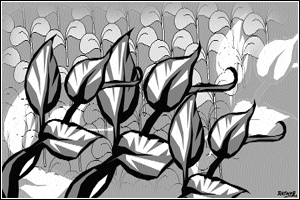 Betel-leaf (Piper betel) is locally known as Pan. It is a masticator having important socio-cultural and ceremonial uses in Sindh and in other parts of the South-east Asia, besides having significant medicinal properties and nutritional values.
Betel-leaf (Piper betel) is locally known as Pan. It is a masticator having important socio-cultural and ceremonial uses in Sindh and in other parts of the South-east Asia, besides having significant medicinal properties and nutritional values.
The plant is a slender, aromatic creeper and show roots at the nodes, and has a heart-shaped smooth, shining and long stalked leaves with pointed apex.
It is a dioeciously ever-green creeper and grown under shades constructed especially for the purpose. Its stem is semi-woody climbing by short adventitious roots having leaves of 5-20 cm long.
It is widely cultivated in India (Tamil Nadu, Madhya Pardesh, West Bengal, Orissa and Uttar Pardesh). In Pakistan, it is particularly cultivated in coastal areas i.e. Thatta and Malir districts.
At present very small quantity of betel leaves are produced in the country, which is about 5 per cent of total consumption in the county. According to an estimation the current consumption of betel leaf in the country is around 5 million kilos and it is expected to increase.
On the other hand, total import of betel leaf from India was reported about 4.5 million kilos, costing around Rs. 140 million. Also the demand of betel leaf is increasing rapidly in the country and it is expected to reach 10 million kilos within few years.
Farming: Land preparation is the first task for betel- leaf cultivation. A good land preparation is necessary for proper and rapid growth of the crop; lot of time and labour is required for land preparation for betel leaf cultivation. From February to March is considered best time for planting it in coastal area.
Growers at present, are using fertilizer without proper guidance. It was investigated that use of fertilizer ranged between 6 to 9 bags of DAP and 2 to 3 bags of NP or nitrate per hectare during the year.
None of the growers has applied urea to the betel leaf. The cost of fertilizer ranges between 7500 to 8500 per hectare.
Fertilizer application must be followed by irrigation water. It may be stressed that application of excessive irrigation with poor drainage causes high N losses both due to leaching and ammonia volatilization.
Some growers claim to apply 8-12 bags of DAP, but of least effect to crop. Betel leaf takes up the fertilizer according to its need, the excess is leached down or is volatilized.
Betel leaf is attacked by number of pests and diseases. The common pests reported are mainly bugs, mites and aphids. The most common disease of betel leaf is foot and leaf rot. It was found that on average Rs7480 per hectare was incurred to control the insect, pests and disease. About 5 betel leaf varieties are commonly grown in the study area.
Betel leaf growers received a price of Rs250 per kg.
They say that there is not much of variation in betel leaf price.
Growers, usually sell their produce to the wholesaler in the city on fixed rate of Rs250/kg. They further pointed out that the lower quality of leaves mostly produced after 15 years are sold at lower prices of Rs150-200/kg.
Growers have to decide weather they should allocate their scarce resources (land, labour, capital and machinery) to plant betel leaf or they should utilize these resources for other crops, taking account of both fixed and variable costs.
The fixed costs of betel leaf were estimated by calculating the initial establishment costs until it starts harvesting.
The variable cost consists of production practices, input costs including FYM, fertilizer and pesticides. The wages for hired labour for irrigation, interculturing, spraying, harvesting, handling, transportation and other management practices have been included in the variable costs.
Marketing costs include transportation, commission charges of commission agents who are intermediaries in between producers and buyer and loading and unloading.
The total costs of betel leaf cultivation are determined to appraise output-input relationship. For this purpose all costs incurred in the betel leaf cultivation are aggregated and presented in (table 1).
Net return: Net returns refer to the residual, which remains for the entrepreneurs after subtracting all production coasts from its gross income. Net returns were determined by subtracting average per hectare costs from average per hectare income realized by the selected growers.
Recommendations: The present government wants to enhance the income of small growers and to improve the economic condition of the resource poor farmers. This is not only possible by increasing per acre yield of major crops, but also to encourage the growers to cultivate high value crops in the region. The cultivation of new crops like sunflower, canola, soybean etc. has already failed in the province due to their competition with the major crops.
Traditionally managed operations and untrained labour, poor planting material are the main causes of low yield of betel leaf in the coastal area of Sindh. There is a need to construct modern commercial farm away from the big cities.
There is need to arrange training of staff for all management operations.













































